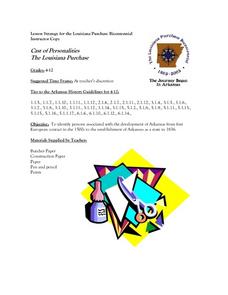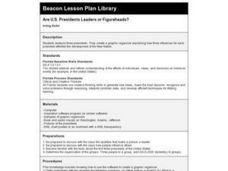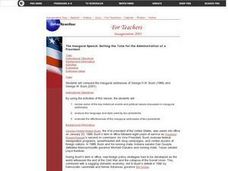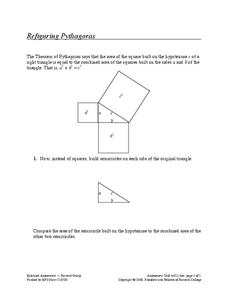Curated OER
What Do You Think of Obama's Oval Office Speech on the Oil Spill?
Kids age 13 and older are asked to read the provided Times article and background information in order to construct a thoughtful blog response to Obama's first Oval Office speech. They work to address each of the related critical...
Theodore Roosevelt Association
Defining America's Role in the World
As the first American president to win the Nobel Peace Prize, and only one of four presidents to do so in United States history, Theodore Roosevelt's foreign policy achievements and preservation of peace are often overshadowed by his...
National Endowment for the Humanities
The 1828 Campaign of Andrew Jackson: Changes in Voting Participation
Students give examples to indicate how voting participation changed in the first half of the 19th century, and make connections between changes in voting participation and the results of the election of 1828.
National Endowment for the Humanities
The 1828 Campaign of Andrew Jackson: Expansion of the Voting Base
Students give examples to indicate how the franchise was extended and limited in the first half of the 19th century, and cite some differences in the newly enfranchised population that could affect the way they would vote.
Curated OER
Cast of Personalities - The Louisiana Purchase
The origins of the state of Arkansas are the focus of this history lesson plan. Elementary schoolers to high schoolers identify persons associated with the development of the state from the very first European contact to statehood in...
Curated OER
Presidents
Fifth graders choose a particular president to research. They define the task of the project, brainstorm questions, list and evaluate possible sources to answer their questions.
National First Ladies' Library
All the News That's Fit to Draw: Political Cartooning and the Presidency
Young scholars research, analyze and study the history of political cartooning in the United States. They recognize a political cartoon, be able to identify the main idea, the symbols and the exaggeration and caricature in political...
Curated OER
Arthur Young and the President
High schoolers work with NASS data by converting it into prose. For this historical agriculture information lesson, students read about how George Washington communicated information about crop yields, livestock, and land values. They...
Curated OER
U.S. Constitution - Selecting the President
Learners study how the electoral college works to select a U.S. President. In this history lesson, students examine the U.S. Elector College methods then answer questions and write an essay that relate to the state where they live.
Curated OER
Chisholm '72: Shirley Chisholm for President
Students view the film "Chisholm '72 - Unbought and Unbossed" about Shirley Chisholm's 1972 bid for the Presidency. They complete a writing assignment in response to the film and participate in class discussion.
Curated OER
New $1 Coins Honor U.S. Presidents
Elementary schoolers examine money, then read a news article about new coins being produced by the U.S. Mint. The teacher introduces the article with samples of American money and a vocabulary activity, then students read the news piece...
EngageNY
End of Unit 1 Assessment: Analyzing an Excerpt from Barack Obama’s Back-to-School Speech
In order to assess their mastery of the concepts taught in a 12-lesson plan unit study of Christopher Paul Curtis' Bud, Not Buddy, individuals read excerpts from President Barack Obama's 2009 Back-to-School Speech and use the strategies...
Humanities Texas
Primary Source Worksheet: Franklin D. Roosevelt, First Inaugural Address
Young historians will learn not to fear primary source materials (or fear itself, for that matter) thanks to this resource that uses Franklin D. Roosevelt's March 4, 1933 Inaugural Address to model how to conduct a close reading of such...
Curated OER
Telegram from Senator Joseph McCarthy to President Harry S. Truman
Young scholars research the McCarthy hearings to determine the following: time frame of hearings, how they were broadcast, how the press reacted, and how the American people reacted in light of the Korean Conflict and the Cold War.
National First Ladies' Library
"Lockwood for President!" Belva Ann, Who?
Students examine the life of Belva Ann Lockwood. They see her life through the creation of a set of "news" articles on her admission to practice law before the Supreme Court in 1879 and her nomination for the presidency in 1884.
Curated OER
Are U.S. Presidents Leaders or Figureheads?
Fifth graders, using a graphic organizer, analyze three presidents.
Curated OER
The Inaugural Speech: Setting The Tone For The Administration Of A President
High schoolers investigate the Inaugural Speech of the President of The United States while comparing two speeches. They conduct research to find the two speeches on the internet and look at them side by side. The lesson includes...
National First Ladies' Library
Women's Lives in the Victorian Era
The lives of middle-class Victorian women were circumscribed by strict standards that governed all aspects of behavior. To gain a better understanding of the Victorian Ideals for women, class members research the life of a middle-class...
Balanced Assessment
Refiguring Pythagoras
Why was Pythagoras so obsessed with squares? The assessment task posits the question of whether the geometric interpretation of the Pythagorean Theorem holds for figures other than squares. Scholars first consider the case of semicircles...
Curated OER
Learning About America
Each slide has a grid to be filled in by a student or team. In order to have that spot active, the student must answer a question about the general history of America and national holidays correctly. There are 10 pages, and each has...
DocsTeach
Nixon Visits China: The Week that Changed the World
Sometimes one trip shakes up the entire world. When President Richard Nixon traveled to China, he defied international and political boundaries. Nixon was the first American president to visit mainland China, which was a communist nation...
Curated OER
The Era of Good Feelings
Setting the context for the first part of the 19th century, the slides presented here display the "Era of Good Feelings," including the presidencies of Monroe and Adams. Maps and photographs help students to contextualize the concepts of...
Curated OER
Kennedy Assassination: Cutting through Conspiracies
First exploring the facts about the John F. Kennedy assassination, this impressive presentation dismantles many popular conspiracy theories about that fateful day. From Jack Ruby's motives to "the magic bullet" to Fidel Castro, the...
Theodore Roosevelt Association
Interpreting the Past; Assessing Its Impact on the Present
Even though the presidency of Theodore Roosevelt ended over 100 years ago, we can still learn something from his stances and policies that is applicable today. Class members first look over a list of prevalent political issues from the...

























